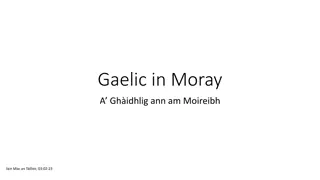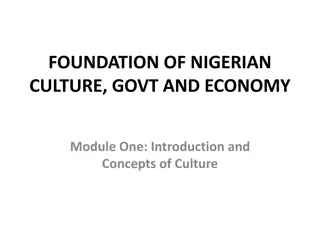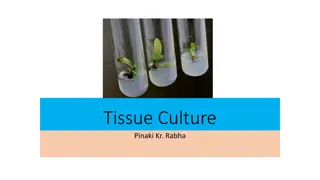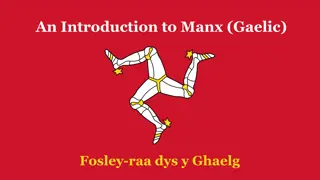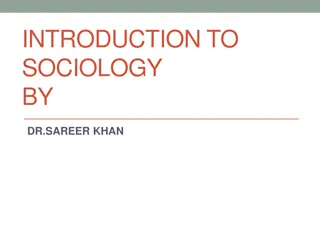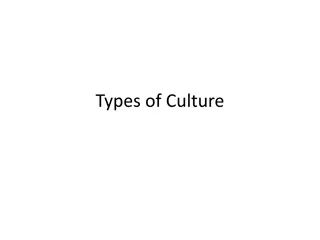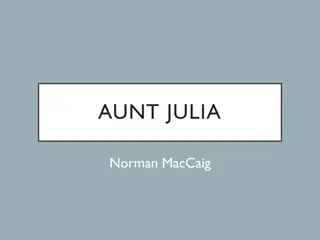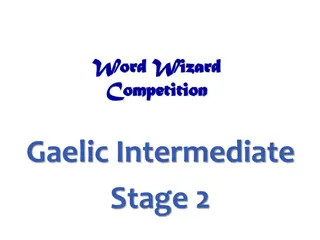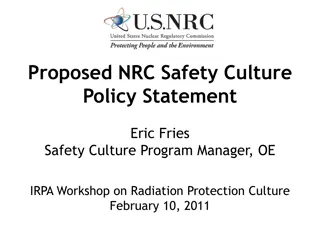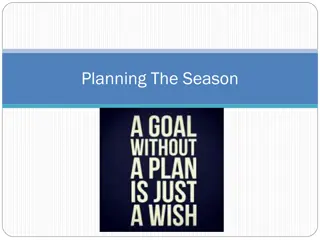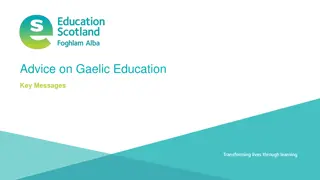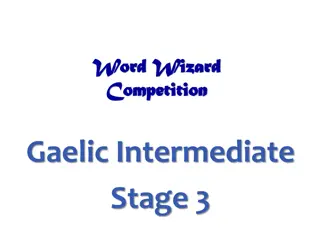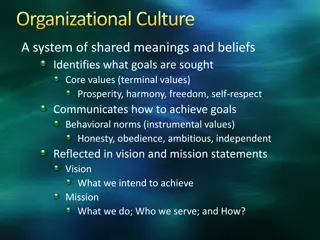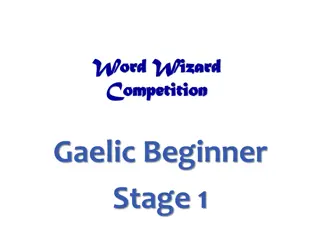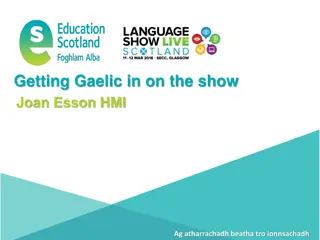Learning about the Hanoverians and Gaelic Culture in Lesson 2
Discover the Hanoverian Royal Family, learn to express where you're from in Gaelic, explore Gaelic place names, understand the clan system in Scotland, and create short texts in Gaelic. Uncover historical details about the Hanoverians and their impact alongside Gaelic language and culture in Scotland.
Download Presentation

Please find below an Image/Link to download the presentation.
The content on the website is provided AS IS for your information and personal use only. It may not be sold, licensed, or shared on other websites without obtaining consent from the author.If you encounter any issues during the download, it is possible that the publisher has removed the file from their server.
You are allowed to download the files provided on this website for personal or commercial use, subject to the condition that they are used lawfully. All files are the property of their respective owners.
The content on the website is provided AS IS for your information and personal use only. It may not be sold, licensed, or shared on other websites without obtaining consent from the author.
E N D
Presentation Transcript
Na Seumasaich The Jacobites Learning about Gaelic Language and Culture Resource Lesson 2 Who were the Hanoverians? and Saying where you are from in Gaelic. For Scotland's learners, with Scotland's educators
Na Seumasaich Lesson 2 In this Learning about Gaelic Language and Culture resource lesson we will learn: about the Hanoverian Royal Family to say where we are from in Gaelic to ask someone where they are from in Gaelic to understand how to say this in contexts about some Gaelic placenames for countries and areas about the clan system in the Highlands of Scotland to create short texts about ourselves and others in Gaelic
Miri and Calum F ilte air ais a Chaluim Welcome back. Tapadh leat a Mh iri C s a tha thu? Tha mi Alba
So last time we learned about the Stuarts and the Jacobites. The Stuarts were replaced by Protestant cousins from Hanover, a part of what is now Germany. The first Hanoverian king was George I. What is George in Gaelic? Did he speak Gaelic? Se ras or De rsa as he was called in Gaelic didn t even speak English! He was a German speaker and even died and is buried in Hanover. Interesting. So being Protestant was more important than being British!
Cit a bheil Hanobhair? Where is Hanover? S mise Se ras. Tha mi s a Ghearmailt. King George I and his sons came from Hanover. The Electorate of Hanover was an area in North West Germany (A Ghearmailt). SCOTLAND HANOVER The British Royal Family would also rule Hanover until 1837 when Queen Victoria became monarch (because she had a male relation who was first in line). ENGLAND At the time of the 1745 Rebellion George s son George II was on the throne. Creative Commons Attribution-ShareAlike 2.5 Generic CC BY-SA 2.5 Oren Neu Dag Creative Commons Attribution-ShareAlike 2.5 Generic CC BY-SA 2.5
Cit an deach na Stibhartaich? Where did the Stuarts go? S mise Te rlach. Tha mi s an Roimh. James VIII and III (The Old Pretender) lived in lands owned by the Pope. Sometimes he lived in Avignon, which is now in France (An Fhraing). His sons Charles and Henry would be born in Rome (An Roimh) in what is now Italy (An Eadailt) The lands owned by the Pope were called the Papal States. The only remaining area of this today is the Vatican City the smallest country in the World in the centre of Rome. Avignon PAPAL STATES Rome Creative Commons Attribution-ShareAlike 3.0 Unported CC BY-SA 3.0 Creative Commons Attribution-ShareAlike 3.0 Unported CC BY-SA 3.0 MrPenguin20
So the Jacobites were Scottish? Not all Jacobites were Scottish. We think they were because of the most famous rebellions, but there were English and Irish ones too! Was every Scot a Jacobite? Not at all. In fact, many Scots were on the side of the Hanoverians. They wanted a Protestant king or at least supported their Clan Chief who was loyal to the present King. Interesting. So it was never an England vs Scotland thing!
Tha mi s an Olaind The first Jacobite Rebellion - 1689 The first Jacobite rebellion in Scotland was in 1689 this ended with the Battle of Killecrankie. The Jacobites won that battle but their brilliant general, Viscount Dundee, James Claverhouse aka Bonnie Dundee was killed by a stray bullet. The Jacobites won thanks to the Highland Charge, where they would run down a hill very fast with swords. At that time it could take over a minute to reload a gun so the enemy soldiers were quickly overrun. This was also the first ever battle in which grenades were used. Tha mi D n Deagh After this battle, King William and Queen Mary demanded every Clan Chief swear loyalty to them The Macdonalds of Glencoe were late in doing so. The Government sent troops from Campbell Argyll to kill them. This is called the Massacre of Glencoe and happened in 1692.
Tha mi s an Olaind The first Jacobite Rebellion 1689 Questions Q1 Why did the Jacobites fail even though they won the Battle of Killiecrankie? Q2 Why did the Massacre of Glencoe happen in 1692? Tha mi D n Deagh
The 1708 Rebellion Measles and Storms Tha mi Breatainn In 1708, just after the Act of Union, James VIII and III tried to invade North East Scotland. He was accompanied by 5000 French and Irish soldiers, but he caught measles, his navy was caught in a storm and the Royal Navy chased them back to France. The French Government supported the uprising because it kept the British Navy busy. They weren t too fussed about the Stuarts retaking the throne, so it was successful for them. However, although many in Scotland were against the new Union with England, people in Scotland did not rise up this time for the Pretender as James VIII & III was called. Tha mi s an Fhraing
The 1708 Rebellion Measles and Storms - Questions Tha mi Breatainn Q1 Why weren t the French upset that the 1708 Rebellion failed? Q2 What nickname did James VIII & III get? Tha mi s an Fhraing
The 15 The 1715 Jacobite Rebellion and Sheriffmuir In 1715, a year after George I took the throne, the Earl of Mar led a larger Jacobite Rebellion. He raised the Jacobite standard (large flag) near Braemar in Aberdeenshire. His army number over 20,000. Tha mi Alba The Jacobites managed to take over almost all of Scotland north of the River Forth. An important battle was at Sheriffmuir near Stirling. The Earl of Mar thought he had won, so the Jacobites retreated and spared a lot of Government troops. The British claimed this as a victory. The Earl of Mar was indecisive. This means he wasn t good at making decisions. His army dwindled to 5000 men. This meant that when James VIII arrived in Scotland in 1716, the campaign was not going as well as expected and he returned home to France. Tha mi Alba
The 15 The 1715 Jacobite Rebellion and Sheriffmuir Questions Q1 Where did the Earl of Mar begin his rebellion? Tha mi Alba Q2 What mistake did he make at Sheriffmuir? Q3 Why did James go back to France? Tha mi Alba
The 19 The 1719 Jacobite Rebellion and Glen Shiel In 1719, some troops from Catholic Spain, supported Highland Jacobites landed in Lochalsh. The big battle here was the Battle of Glen Shiel. You drive through the battlefield on the road to the Isle of Skye. Tha mi s an Sp inn This was the first battle to use mortars. The Spanish troops tried to escape by running up the steep sides of the glen. They were captured and sent back to Spain. The Jacobites had stored their weapons at Eilean Donan Castle, which is now a famous tourist landmark. The British came and blew them up. As revenge, the British invaded Vigo in North West Spain and held it for ten days. After this the Spanish stopped supporting the Jacobites.
The 19 The 1719 Jacobite Rebellion and Glen Shiel Questions Q1 What kind of weapons were used for the first time at Glen Shiel? Tha mi s an Sp inn Q2 What happened to Eilean Donan Castle?
How to talk about where you are from in Gaelic. C s a tha sibh? To say I am from in Gaelic, you say Tha mi or Tha mi s To ask someone where they are from you, you ask C s a tha thu? Or if they are older or there is more than one C s a tha sibh? Tha mi Alba Tha mi irinn Tha mi s an Fhraing Tha mi s an Eadailt
Research find out the Gaelic for the following Scottish places. Saying where we are from in Gaelic There are two ways to say from in Gaelic or s We use Tha mi for most placenames We use Tha mi s for placenames which begin with The in Gaelic (A , An, Am or Na) this is common for most countries in Europe but we also see it with The Highlands - A Gh idhealtachd Glasgow Edinburgh Dundee Aberdeen Inverness Perth Stirling Fort William Oban Dumfries Orkney Shetland Elgin Isle of Skye Tha mi s a Gh idhealtachd
Dthchannan Erpach European Countries You ll see which countries use Tha mi and which use Tha mi s. Tha mi Alba Tha mi s An Sp inn An t-Suain Sasainn An Fhraing An Ugrain Nirribhidh A Ghearmailt An Eadailt irinn An Olaind A Pholainn Breatainn An Danmhairg
Task one Asking and saying our names in Gaelic Your teacher will ask you C s a tha thu? Reply with Tha mi Alba I am from Scotland If you want to say you are from another country, don t worry, your teacher can give you the answer for that. See below for an example. Caleb, C s a tha thu? Tha mi Alba
Task two - writing You are going to add to your two profiles one for yourself, and one for a Highlander boy or girl from the time of the Jacobites. Example S mise Chloe Kowalcyk Tha mi s a Pholainn S mise Mairead NicLe id Tha mi Alba Write a sentence in Gaelic stating your first name and surname. Write a sentence in Gaelic stating where you are from. S mise Ruairidh Caimbeul Tha mi Sasainn S mise Iseabail Sti bhart Tha mi Alba Then do the same for your Highlander.
Hai. D an t-ainm a th ort? Task three - talking Go around the class and follow this example. Greet each other with a simple Hai or Hal Hal S mise Calum MacLe id. C s a tha thu a Chaluim?. Ask each other your name using D an t-ainm a th ort? Tha mi Alba. Then ask each other where you are from C s a tha thu?
Task four - talk Hal . S mise Seumas. Tha mi Nirribhidh. Choose a country that you haven t used already. Go round the class and introduce yourself and then state where you are from. Hal S mise Calum! Tha mi s an Olaind. Hai s mise Anna. Tha mi Sasainn.
Task five - factfile Research one of the following Battles Killecrankie (1689), Sheriffmuir (1715) or Glen Shiel (1719). Present your findings and try and include the following. A map of Scotland to show the location A diagram of how the battle happened Some statistics about how many people fought and died Some interesting facts about things that happened or people who fought Any other relevant information or images
Education Scotland Denholm House Almondvale Business Park Almondvale Way Livingston EH54 6GA T +44 (0)131 244 5000 E enquiries@educationscotland.gsi.gov.uk For Scotland's learners, with Scotland's educators




